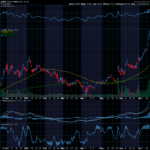A call option is out of the money when the underlying asset price is lower than the strike price. A put option is out of the money when the underlying asset price is higher than the strike price.
Out of the money is a term used to describe an option contract that does not have intrinsic value. This means that the current market price of the underlying asset is not favorable for the holder of the options contract to exercise their right to buy or sell the asset at the strike price. For example, imagine you buy a call option on Company XYZ with a strike price of $50, but the current market price of Company XYZ shares is only $40 per share. In this case, your call option is out of the money, as you would have to pay $50 per share to buy the shares under the options contract, which is more than the current market price. If the price of Company XYZ shares does not increase above the strike price before the expiration date, the option will expire worthless and you would only lose the premium (cost) paid for the option. Conversely, if you buy a put option on Company XYZ with a strike price of $50, but the current market price of Company XYZ shares is $60 per share, the put option is also out of the money, as it would not make sense to exercise the option to sell shares at a lower price than the current market price.





Recent Comments